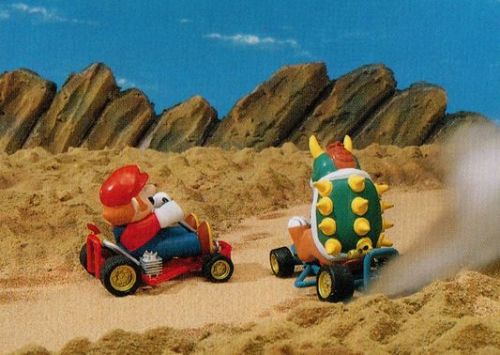
Unlicensed New Super Mario Bros. comforter, with the logo being changed to “New HAPPY BOYS.” and both Mario and Luigi using Mario’s design but displaying an “L” (mirrored in Mario’s case) on their caps.
Nicholas.a.burgessNew Happy Boys

In Super Mario Bros. 3, the rock between the path to the first fortress in World 4 and the Spade Panel can be destroyed with a Hammer item, allowing the player to bypass the fortress. There is no obvious indication that this rock is destructible, as it is surrounded by decorative rocks. In fact, many guides for Super Mario Bros. 3 do not mention this shortcut. (Footage recorded by me in a NES emulator.)

Koopa Troopa car from a series of Super Mario Kart toys.

Actor Wil Wheaton with his younger brother Jeremy and Mario at the 1987 Beverly Hills “Super Mario-A-Thon”.
With a high score of 239,400 points, Wil had the highest score of all celebrity guests invited. See also other guests.
Nicholas.a.burgessThat face

Unlicensed gold and silver Waluigi charms.
Nicholas.a.burgessPoignant.

Characters leaving the camera’s field of view and ceasing to be rendered piece by piece in Mario Party 2.
Nicholas.a.burgessAmazing

In various levels throughout Super Mario World, bonus rooms where groups of three blocks must be hit in the correct order for a 1-Up can be found. There is a way to cheat at this mini-game and always collect every 1-Up by entering the bonus room as Cape Mario carrying a Koopa shell. By placing the shell on the ground and spinning Mario’s cape to make it hit the blocks, every hit registers as correct regardless of the order.
Nicholas.a.burgessthank god this blog is updating again when we need it most


By removing the foreground layer, we can see what Blarggs in Super Mario World look like beneath the lava.


Nicholas.a.burgessAnimated bananas and banana bunches










Animated bananas and banana bunches from Donkey Kong 64.
Nicholas.a.burgessNot creepy at all



Promotional art for Virtual Boy Wario Land showing the Virtual Boy’s 3D effect by having Wario slowly come closer to the viewer.










From a Japanese guide for Super Mario Kart.
Nicholas.a.burgessSo much gold in this blog


From a Japanese guide for Super Mario World.

Racers in Mario Kart 64 from the side. Every racer is a 2D sprite that is always turned towards the camera.
Nicholas.a.burgessThis particular post is okay, but this blog as a whole is great.

In Super Mario Bros. 2, standing on a log while a POW Block hits the ground will make the log ascend to the top of the screen with your character.


 |
| Some bike lanes were painted in an effort to try and do something, anything at all, but despite the well-meaning effort, the street remains a major problem. |
Nicholas.a.burgessGet me off of this planet!
Nicholas.a.burgessThere are some good ones in here.
Rep. Colleen Garry, a Democrat from Dracut, proposed making it a felony to block highways. She told the Lowell Sun she was furious about the Thursday morning protests that blocked two sections of the heavily traveled highway through Boston, one north of the city and one south.
"I'm just outraged that people would be that reckless," Garry said. "Everyone has a right to protest, but to do that kind of thing in a highway or a roadway?" [...]
Nearly 30 protesters were arrested and arraigned on charges including trespassing, disorderly conduct, resisting arrest and willfully obstructing an emergency vehicle.
State police said an ambulance transporting a seriously injured car crash victim to a Boston hospital was forced to divert to a hospital outside the city that did not have a trauma unit. The man survived.
State Sen. Richard Ross, a Wrentham Republican, filed legislation that would impose a minimum $5,000 fine and allow a jail sentence of up to six months for willfully trespassing on state highways. Current law allows for a maximum $50 fine and a jail term of no more than three months.And the same week, State to propose opening S. Boston Bypass Road to all drivers:
State transportation officials will file a notice in February with Massachusetts environmental regulators to allow cars coming into South Boston to use the Bypass Road, which is currently restricted to trucks and other commercial vehicles. The pilot program would last six months and could begin as soon as March. [...]
The 1.1-mile road was built to accommodate trucks during the construction of the Central Artery, and when the tunnels were done, the road remained restricted. But as traffic becomes heavier in the fast-growing Seaport District, there has been pressure to open up the road to everyone. [...]
As part of its filing, the state will also propose letting all drivers use the high-occupancy vehicle lanes outside of South Station and the South End.These two pieces of news are, in fact, related: because together they illustrate the hypocrisy and insincerity of our Commonwealth's transportation policy with regard to emergency vehicles. If our elected officials truly cared about emergency vehicle response time -- which they should -- then they would put a quick end to this proposal that will destroy the efficacy of both the South Boston Bypass Road as well as the HOV lanes outside of the South End. If not, then it is quite clear that these politicians, Rick Ross and Colleen Garry, are merely posturing and mouthing platitudes, all while silently sticking it to emergency responders. By far the most common obstacle for emergency vehicles on our roads is not protesters: on a daily basis, emergency vehicles are obstructed by other motorists and the traffic jams created by motor vehicles.
 |
| BU Bridge under renovation (source) |
"There's going to be road rage," predicted Stanley Spiegel, who lives across the bridge in Brookline. "If you're going to spend public money to go for an improvement, you don't predictably make things worse.This kind of attitude shows zero concern for the safety of anyone else, but it is sadly all too common among entitled motorists of Mr. Spiegel's ilk. Whenever safety or emergency response goals conflict with increased car capacity, we can see quite clearly where motorists like him stand. Thankfully, in the case of the BU Bridge thus far, MassDOT has not capitulated to the bullies who would remove the shoulder space and turn it back into a fourth congested travel lane.
 |
| The South Boston Bypass Road (source) |
Nicholas.a.burgessGood article at the other end.
In short: There is no plan to resolve the dispute over cost overruns, which are ubiquitous on projects like this; at $4.2 billion, it’s the most expensive transportation project in state history. The tunnel will have no exits — no ingress or egress — throughout the entire downtown core (which makes the support of downtown businesses all the more mystifying). It won’t allow transit, only cars. It will be tolled, highly enough, by the state’s own estimates, to drive nearly half its traffic onto the aforementioned side streets. It will be a precarious engineering feat, the widest deep-bore tunnel in history, digging right between a) Puget Sound and b) the oldest part of Seattle, with vulnerable buildings and God-knows-what buried infrastructure. Also: Pollution. Climate change. It’s the 21st f’ing century. On and on. People said all this and more, in real time, to no avail.
Nicholas.a.burgessI'm just sharing every post from here.
 |
| Game lets you play Pong with a person on other side of the crosswalk (source) |
The ActiWait is a new generation of traffic light buttons. Installed at a pedestrian traffic light with long red phases, it offers pedestrians the possibility to convert boring waiting times into positive experiences. Through a touch screen which is installed in the upper shell of the button, people can interact with each other across the street.
 |
| Slides from Ricardo Olea, SF MTA (source) |
 |
| "SPOT app" (source: BostInno) |
Nicholas.a.burgessI liked the article at the other end of the link.
Nicholas.a.burgessJust one of the many things I'm depressed about!
When a party suffers a major setback, everyone comes forward with their diagnosis of the problem. And in most cases their diagnosis of the problem tells us that the solution is what the diagnoser wanted to do more of in the first place. This is just human nature. We see the evidence before us as confirmation of what we already thought. When I'm asked these kinds of questions, what I always say is that we should be highly skeptical of anything that suggests the answer is obvious or simple to execute. Because for all the groupthink and folly and insular thinking of political professionals, they're generally fairly bright and they have huge personal and professional incentives to win. If it were really that obvious, someone would have tried it already.
Read More →